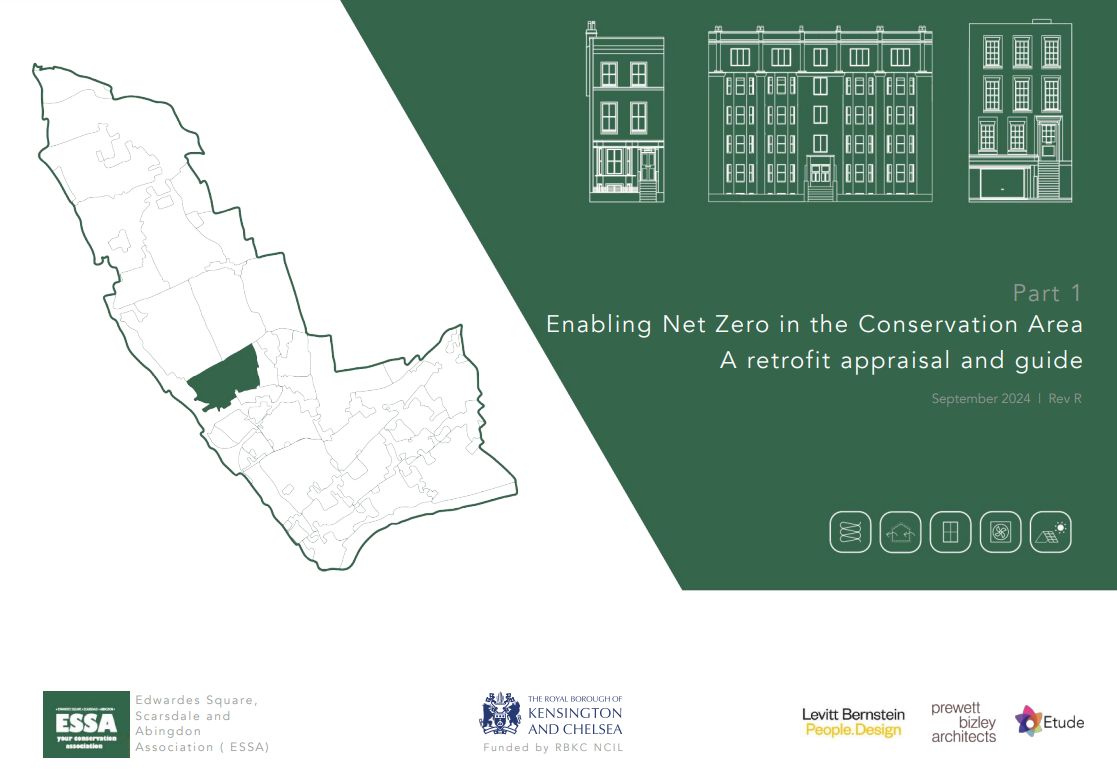Retrofit guidance developed for the ESSA Conservation Area.
This guidance is a suite of four documents developed for the Edwardes Square, Scarsdale and Abingdon (ESSA) Conservation Area. These documents have been developed in order to explain what retrofit means and how residents in the area can improve their homes while reducing its carbon emissions by more than 90% in a conservation area.
Enabling Net Zero in the Conservation Area
 A joint effort between residents and the Council
A joint effort between residents and the Council
Climate change is one of the main challenges of our time and it cannot be solved by Government alone. It requires coordinated action from residents and the Council, and every level of society.
Taking the ESSA Conservation Area to Net Zero
The Royal Borough of Kensington and Chelsea (RBKC) is targeting Net Zero by 2040 for the whole borough, leading by example with its own estate. This means that conservation areas, which cover approximately 73% of the borough, need to achieve Net Zero by 2040 too. This retrofit appraisal and its associated guides for residents focus on the Edwardes Square, Scarsdale and Abingdon (ESSA) Conservation Area but they will largely be relevant to other conservation areas in the borough. This work has been commissioned by ESSA, with support and funding via the RBKC Neighbourhood Community Infrastructure Levy (NCIL), in order to articulate how residents can put their homes on track to Net Zero and which retrofit measures should be generally supported in order to respond to both conservation and climate change responsibilities.
Conservation of our heritage and our climate
This study seeks to inform residents and show that it is possible for them to reduce their homes’ carbon emissions ambitiously whilst maintaining the character of the Conservation Area.
Respecting the past and the future
The ESSA Conservation Area is an important conservation area in the Royal Borough of Kensington and Chelsea. The historic environment of the ESSA Conservation Area is a shared asset and a rich and diverse part of London’s cultural heritage. We have a duty to preserve this heritage.
In parallel, we also have a duty to address climate change. All buildings have a role to play in that. Key objectives in this respect are to enable buildings to use less energy, to stop burning gas and other fossil fuels, and to contribute towards the generation of renewable energy. This can be achieved through planned and whole-house retrofit programmes for individual or groups of properties.
ESSA’s history and characteristics should inform the selection of suitable retrofit measures available to residents to decarbonise their homes while making them more comfortable and sustainable.
The key challenge of implementing domestic retrofit at scale within conservation areas is balancing conservation objectives with management of sustainability-led change.
The importance of a ‘whole-house approach’
A ‘whole-house approach’ to successful retrofit is championed by organisations ranging from Historic England to the Sustainable Traditional Building Alliance. Benefits can be maximised and risks minimised if the undertaking is premised on a thorough understanding of the asset including significance and context, building fabric condition, and occupant needs.
Simplifying the challenge and providing guidance to residents
There are many different types of buildings and construction types within the ESSA Conservation Area. Appropriate retrofit measures may differ depending on the building, but are broadly similar. In order to provide clear, actionable advice that is relevant to most buildings in the area, three ’retrofit archetypes’ were identified, and three distinct Resident Retrofit Guides prepared.
‘Retrofit archetypes’ are groups of buildings that share similar features and are likely to require similar interventions to make them low energy and compliant with Net Zero. Retrofit archetypes might be easily identifiable as belonging to the same group of buildings, but in some instances, they may also look different yet still require the same retrofit strategy.
Low-carbon retrofit measures can be successfully integrated into traditional buildings
Retrofit measures are explored in Section 5 and grouped by:
- windows
- insulation
- air-tightness and ventilation
- heating systems
- renewable energy
Consideration is given to each measure in the context of the Conservation Area, Listed Building status, and characteristics of traditional buildings.
Replacement of windows represents the biggest opportunity for energy savings. Wall insulation (internal or external) can deliver good energy savings but consideration should be given to the options, their effectiveness, moisture risks, and level of disruption to occupants.
The transition to low-carbon heat away from gas is a critical step for all buildings and generating renewable energy with roof-mounted PVs represent a significant opportunity.
The third perspective: the residents
In addition to issues of conservation and climate change, building owners and occupants (the residents) are absolutely key to ensuring low-carbon retrofit happens and is done in an appropriate and sensitive manner for the homes they live in. It is therefore important to provide high-quality advice, clarity, and address as far as possible barriers that might discourage intervention.
Delivering these measures in practice
Disruption, cleaning and maintenance, cost, and the ability to remain in the home while works are carried out are all considerations that residents will make when deciding which retrofit measures to do. Take windows as an example – their improvement is crucial for energy efficiency. If choice is reduced, on all elevations, to evacuated glazing in similar frames or advanced secondary glazing, it may be restrictive to the extent that they may be discouraged by cost or the practicality of secondary glazing (e.g. cleaning, ventilation). Opening up the choice to a wider range of high-performance, high-quality windows, particularly for the back elevations, is important and could help to enable more low-carbon retrofits.
Clarity and appropriate advice
Developing a common understanding of what is likely to be acceptable from a conservation and planning point of view in the majority of cases is important for residents and officers alike. The resident retrofit guides will help building owners and residents develop low-carbon retrofit plans that achieve a successful balance between conservation and climate change.
The guides
End of Preview
